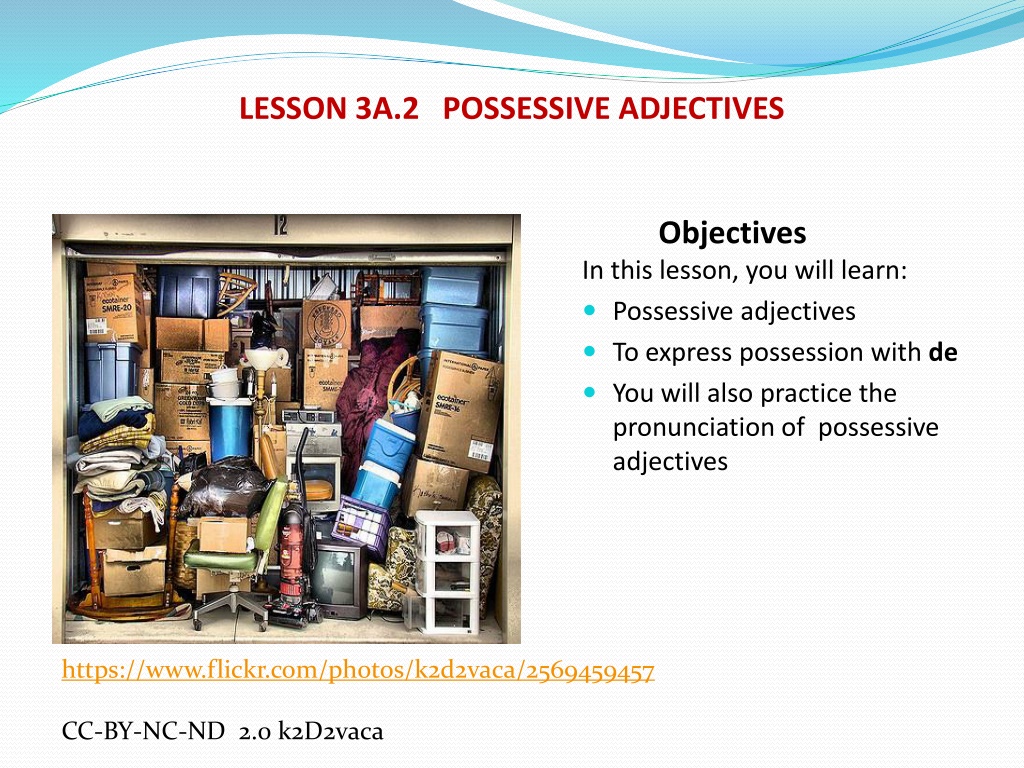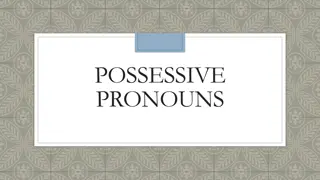Learning Possessive Adjectives for Expressing Possession
This lesson teaches possessive adjectives to express possession in French, focusing on pronunciation and usage rules. Learn about masculine, feminine, and plural forms, and practice translating sentences using "de."
Download Presentation

Please find below an Image/Link to download the presentation.
The content on the website is provided AS IS for your information and personal use only. It may not be sold, licensed, or shared on other websites without obtaining consent from the author.If you encounter any issues during the download, it is possible that the publisher has removed the file from their server.
You are allowed to download the files provided on this website for personal or commercial use, subject to the condition that they are used lawfully. All files are the property of their respective owners.
The content on the website is provided AS IS for your information and personal use only. It may not be sold, licensed, or shared on other websites without obtaining consent from the author.
E N D
Presentation Transcript
LESSON 3A.2 POSSESSIVE ADJECTIVES Objectives In this lesson, you will learn: Possessive adjectives To express possession with de You will also practice the pronunciation of possessive adjectives https://www.flickr.com/photos/k2d2vaca/2569459457 CC-BY-NC-ND 2.0 k2D2vaca
OVERVIEW This lesson introduces you to the possessive adjectives. (my, your, their, etc.) Two important things to remember: Possessive adjectives are always placed before a noun. They agree in gender and number with the noun: Ma tante (my aunt) feminine, singular mes tantes (my aunts) plural (masculine or feminine)
Possessive adjectives Masculine singular feminine singular plural Mon ma mes my ton ta tes your (fam. and sing) son sa ses his/her notre notre nos votre votre vos your (form. or plu.) leur leur Notice also the following: -Changes before a vowel: Mon amie (In theory, it should be ma amie-my female friend) our leurs their
Possession with de -Possession using DE (= s) Example: C est le chien de Roselyne (It's/this is Roselyne s dog) Ce sont les chats de Claude (These/those are Claude's cats) Notice: Les livres de l' tudiant Les livres des (=de+les) tudiants Les livres du (=de+le) professeur Remember that you need the definitive article (le, la, les) before a title (monsieur, professeur, tudiant, docteur, chef, etc.). You must take this into account when expressing possession with "de". Ce la classe de Dominique Ce la classe de l tudiante
PRACTICE Translate the following sentences using de 1. It s Kate s notebook___________________________________________ 2. They are the President s children________________________________ 3. It s my friend s mother________________________________________ 4. Those are Claudine s pencils___________________________________ 5. It s my sister s problem_______________________________________ Answers 1. C est le cahier de Kate 2. Ce sont les enfants du President 3. C est la m re de mon ami/e 4. Ce sont les crayons de Claudine 5. C est le probl me de ma soeur CC-BY Roger Celis




























